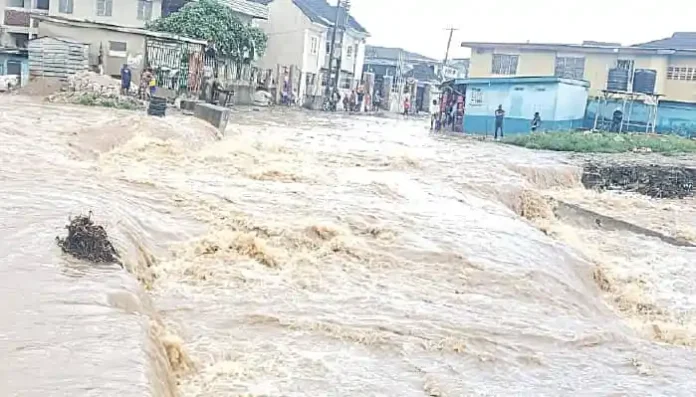THE Federal Government’s latest alert—issued through the Federal Ministry of Water Resources and Sanitation in collaboration with the Nigeria Hydrological Services Agency (NIHSA)—has once again brought to the fore the persistent threat of flooding in Nigeria. The unveiling of the 2025 Annual Flood Outlook (AFO) in Abuja highlights a troubling continuity of risk, underscoring the urgent need for proactive and sustained measures to mitigate the devastating impact of seasonal floods.
The Minister of Water Resources and Sanitation, Engr. Prof. Joseph Utsev, while presenting the 2025 AFO themed “Flood Resilience: Focusing on Communities Preparedness and Adaptation Strategies for Flood Management,” emphasised the growing vulnerability of communities across the country. According to him, 1,249 communities across 176 Local Government Areas (LGAs) in 33 states and the Federal Capital Territory (FCT) fall within high flood risk zones, while another 2,187 communities in 293 LGAs in 31 states are within the moderate flood risk category. These figures, staggering as they are, reaffirm the reality that flooding remains one of Nigeria’s most destructive natural disasters.
This builds on the previous year’s projection. In 2024, the AFO had already warned that 148 LGAs in 31 states were at high risk of flooding between April and November. With the growing trend of climate variability, rapid urbanisation, and unchecked human activities, the situation appears to be worsening rather than improving.
Perennial flooding has remained a blight on the country’s development, affecting everything from agriculture and livelihoods to infrastructure and public health. Despite repeated warnings from meteorological and hydrological agencies, many communities continue to suffer from the same cycle of preventable destruction. The reasons are familiar: poor urban planning blocked drainage systems, settlements on floodplains, and inadequate response strategies.
The 2022 floods, widely regarded as the worst in Nigeria’s history, serve as a stark reminder of what is at stake. Affecting 33 out of the 36 states, these floods displaced over 1.4 million people, injured more than 2,400, and resulted in the destruction of over 82,000 homes. They also damaged over 330,000 hectares of farmland and claimed the lives of 603 persons. To compound the tragedy, the northern region experienced a cholera outbreak due to contaminated floodwater, which killed at least 64 individuals.
With the new 2025 outlook already painting a dire picture, we call on all tiers of government and relevant agencies to act decisively and swiftly. It is not enough to respond only after the damage has been done. Agencies like the National Emergency Management Agency (NEMA), State Emergency Management Agencies (SEMAs), and local authorities must activate and communicate flood preparedness plans early, especially to vulnerable communities along coastal and riverine areas. Awareness campaigns, pre-positioning of relief materials, evacuation strategies, and community mobilisation must all be scaled up ahead of the peak rainy season.
Equally crucial is the judicious use of funds allocated for flood mitigation. Allegations of fund misuse, such as those levelled at NEMA in 2022 over the Ecological Fund, must be investigated and prevented from recurring. These funds should be strictly deployed to build resilience, not to enrich a few.
In the long term, Nigeria must address the root causes of flooding. Public enlightenment is needed to dissuade building on waterways and dumping waste in drains. Infrastructure must be upgraded through regular dredging of water bodies and construction of flood defences such as levees, embankments, and retention dams.
One glaring failure is the abandonment of the Dasin Hausa Dam project—intended as a counterpart to Cameroon’s Lagdo Dam. The latter is periodic water releases exacerbate flooding in downstream Nigerian communities, yet over 40 years later, Nigeria has failed to construct its promised mitigation dam. Completing such infrastructure projects is no longer optional; it is a national imperative.
Additionally, multipurpose dams can serve irrigation needs during the dry season, contributing to food security and economic stability. With climate change intensifying rainfall patterns, Nigeria cannot afford to remain unprepared year after year.


